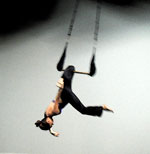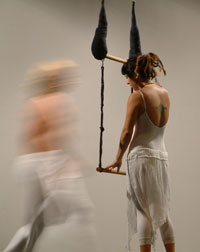|
Aerial dance sweeps the nation
By Molly Thomas, USA TODAY.com
Attached to a rope between a cliff and the Lost Aero Spire
in Yosemite National Park, Amelia Rudolph begins to untie the
knot that is holding her on the rigging system 2,800 feet in
the air. As the knot comes free, Amelia falls through the air
to be rescued by the second rigging system. At that moment,
Rudolph says she briefly gets nauseated and her nerves nearly
get the best of her. Then she begins to dance.
Suspended, she rolls in her harness turning upsidedown and
spinning in different directions. She gestures with her hands
and head, moving within her own interpretation of a swift, a
small bird known for its rapid flight and shrill screams.
Experienced mountain climber - and dancer. As the founder
and artistic director of Project Bandaloop, an aerial dance
company that combines dancers with climbers and riggers,
Rudolph describes her career as invigorating because it allows
her to do things she couldn't do anywhere else.
"Aerial dance is movement generated by the
cross-pollination of dance, climbing, and aerial work,"
Rudolph says. "The dance sense of it comes in with the
artistry, the connection of one movement to the next. When I
fly out into the air off of the tenth story of a building and
I am suspended for 10 seconds, that is just beautiful movement
to watch."
Aerial dance is a new trend catching on in the dance world,
especially in the western United States. This week,
aerial dance companies from around the country are gathering
in Boulder, CO to share ideas, learn new techniques, develop
new apparatus and perform at the annual Aerial Dance Festival.
Nancy Smith, the founder and artistic director of Frequent
Flyers Productions, formed in 1988, is coordinating the event.
"I think that aerial dance is just now starting to appeal
to a bigger public," Smith said. "The art form brings in
people from all walks of life who are taking aerial dance in
many different directions. The festival is a chance for us to
bring all of those ideas together."
Aerial —or vertical —dance has been around since the
1970s. The idea that forms the foundation is
that of taking dance elements into the air using special
apparatus.
One of the best known pioneers in the art form is
67-year-old Terry Sendgraff, a dancer who began working with
the low-flying trapeze in 1975. Sendgraff wanted to bring
something new to choreography. In a birthday performance for
family and friends, Sendgraff incorporated trapeze work into
her dancing. With that performance, Sendgraff kicked off the
unique combination of circus art with dance that has taken 25
years to gain substantial popularity.
"Aerial work has been around in the circus for a long
time," Sendgraff said. "But aerial dance is different because
it brings an internal passion to the performance. Flying and
moving in the air has always been something symbolic for the
dance world, but now it is real."
At first, Sendgraff met opposition from traditional members
of the dance community.
"People were reluctant to take me seriously at first,"
Sendgraff said. "They claimed it wasn't dance, but I was
serious and stuck with it. In the end, it made me very happy
to see that people found enjoyment from watching me
perform."
As Sendgraff continued in her pursuit, she became the
inventor of the single-point trapeze, an apparatus where the
two ropes of the trapeze connect to a single attachment point,
allowing an element of spinning as well as swinging.
Sendgraff inspired many people to take to the air
developing and utilizing new apparatus like climbing walls,
steel poles and flying boxes and discs, as well as take aerial
dance into different environments.
Orts Theater of Dance, a company that originally began as a
modern dance company 17 years ago, is taking its aerial dance
form overseas. The company has performed in Mexico, Central
America, Ecuador, British Islands and St. Petersburg, Russia.
Anne Bunker, the artistic director for O-T-O Theater of Dance,
says she believes it is important to open the world up to
aerial dance.
"I think we should bring the art form into countries that
are now emerging into contemporary dance and expose them to
aerial dance," Bunker says. "We teach these countries through
extensive workshops so that the form can eventually become
international."
For Rudolph and Project Bandaloop, one foot is inside the
concerting world and one is inside the climbing world. While
they continue to perform in rigged theaters, the company
enjoys celebrating natural spaces as well.
"One of the most exciting performances we ever did was a
vertical adaptation of Romeo and Juliet out of the 23rd story
of a skyscraper in Houston," Rudolph says. "We were 350 feet
in the air with the Houston Symphony below us and 40,000
people watching. It was magical, and it had quite an impact on
people."
When trying new equipment and techniques, safety is always
an issue. Project Bandaloop uses a system of three checks to
make sure its dancers are safely secured. According to
Rudolph, the biggest problem is human error.
At the same Houston skyscraper show one of Bandaloop's
dancers got through the first two checks without anyone
noticing her harness was fastened incorrectly. A rigger caught
the mistake on the third and final check before she was
suspended.
"We go into this field with the philosophy that the way to
be the most safe is to assume that something will go wrong,"
Rudolph says.
Despite the risks involved and the struggle to get their
art recognized, Rudolph and the other aerial dancers are
continuing to practice their art from the tops of mountains to
skyscrapers with theaters in between. | 

